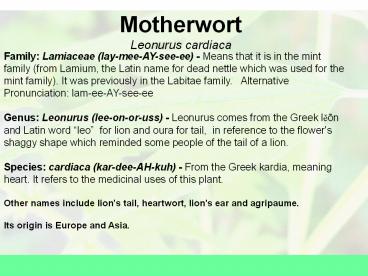Motherwort Leonurus cardiaca PowerPoint PPT Presentation
1 / 10
Title: Motherwort Leonurus cardiaca
1
MotherwortLeonurus cardiaca
Family Lamiaceae (lay-mee-AY-see-ee) - Means
that it is in the mint family (from Lamium, the
Latin name for dead nettle which was used for the
mint family). It was previously in the Labitae
family. Alternative Pronunciation
lam-ee-AY-see-ee Genus Leonurus (lee-on-or-uss)
- Leonurus comes from the Greek leon and Latin
word leo for lion and oura for tail, in
reference to the flower's shaggy shape which
reminded some people of the tail of a
lion.Species cardiaca (kar-dee-AH-kuh) - From
the Greek kardia, meaning heart. It refers to the
medicinal uses of this plant. Other names
include lions tail, heartwort, lion's ear and
agripaume. Its origin is Europe and Asia.
2
Motherwort
Motherwort is an upright plant that can grow to
more than 1.2m tall. It is herbaceous, usually
with one stem but sometimes branching with some
retrorse pubescence in the angles. The stem is
squarish and hollow.
3
Motherwort
The dark green above, pale below leaves are
opposite with petioles and often with three
different shapes on the same plant. The lower
leaves often resemble a silver maple with large
lobes and coarse teeth and are more pubescent
than the upper leaves.
4
Motherwort
The inflorescence appears in auxiliary clusters
of 11-12 sessile flowers almost completely
surrounding the stem.
5
Motherwort
The hairy, pinkish flowers are small ranging from
just smaller than a cm to just over a cm in size.
The flowers are hermaphrodite (has both male and
female organs) and are pollinated by bees. It
blooms from July to September.
6
Motherwort
Motherwort
Future location of photo.
The fruit ripen from August to September.
Motherwort grows in disturbed areas of Altona
Forest such as near the parking lot and in some
areas of the northern regeneration area.
7
Motherwort
The leaves and flowers of this mint family plant
are used medicinally. In times past, the whole
plant was harvested when in flower and dried for
later use. The early Greeks gave motherwort to
pregnant women suffering from anxiety. This use
gave it the name mother wort, or mothers herb.
The ancient Greeks and Romans used motherwort to
treat heart palpitations and depression, which
they considered an illness of the heart. A
legend relates that one town got its water from a
stream flowing through banks covered with
motherwort. Many of the townspeople lived to be
130 years old or more and they attributed this to
the motherwort.
Motherwort
8
Motherwort
Motherwort
In Chinese herbal medicine, the seeds are also
employed to promote longevity. Japanese use the
flowers of motherwort in a drink for the same
purpose. They have a Motherwort festival on the
ninth day of the ninth month called "Kikousouki".
During this time, Motherwort flowers are eaten in
rice and added to saki. In Europe, motherwort
was originally used as a treatment for cattle
diseases and to solve ailments of the heart as
well strengthening the uterus, aiding in labour
and to relax the womans womb after childbirth.
North American colonists brought motherwort to
this continent and the 19th century herbalists
recommended it to promote menstruation and to
aid in expelling the afterbirth. It was also used
to relieve bronchitis and asthma. The Cherokees
used the herb as a sedative. In Victorian England
it represented concealed love.
9
Motherwort
In parts of China today women still drink a syrup
made from motherwort to promote the recovery of
the uterus after childbirth. Some countries of
Europe still use motherwort as a sedative, to
treat heart disorders caused by stress, as an eye
wash and to help an overactive thyroid
(hyperthyroidism). Motherwort is sometimes used
as a condiment, used as a flavouring in soups or
beer or taken as a tea. Testing is ongoing and
there are some concerns about prolonged use.
Dermatitis in susceptible people sometimes
results from contact with this plant. As
always, no medical use of this or any other herb
should be taken without a physicians advice.
Other uses include using the dark olive-green
dye obtained from the leaves. The crushed pants
give off an agreeable odour when handled.
10
To Return to the Plant ListClick on the Trout
LilyBelow
Return to mints.
- To end this program click on this box.

